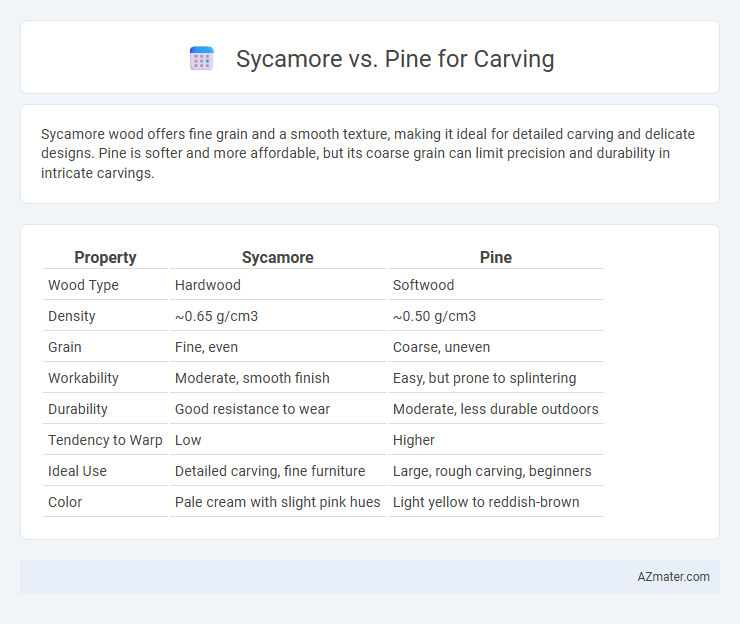Sycamore wood offers fine grain and a smooth texture, making it ideal for detailed carving and delicate designs. Pine is softer and more affordable, but its coarse grain can limit precision and durability in intricate carvings.
Table of Comparison
| Property | Sycamore | Pine |
|---|---|---|
| Wood Type | Hardwood | Softwood |
| Density | ~0.65 g/cm3 | ~0.50 g/cm3 |
| Grain | Fine, even | Coarse, uneven |
| Workability | Moderate, smooth finish | Easy, but prone to splintering |
| Durability | Good resistance to wear | Moderate, less durable outdoors |
| Tendency to Warp | Low | Higher |
| Ideal Use | Detailed carving, fine furniture | Large, rough carving, beginners |
| Color | Pale cream with slight pink hues | Light yellow to reddish-brown |
Introduction: Sycamore vs Pine for Carving
Sycamore offers a fine, even grain and smooth texture, making it ideal for detailed carving and intricate designs. Pine, being softer and more porous, carves easily but may show more tool marks and require additional finishing. Choosing between sycamore and pine depends on the desired detail level and finish quality for the carving project.
Wood Grain and Texture Comparison
Sycamore wood features a fine, even grain with a uniform texture, making it ideal for detailed carving and smooth finishes. Pine has a more pronounced grain with visible knots and a softer texture, which can challenge precision but adds rustic character to carvings. Carvers often choose sycamore for intricate artwork while pine suits larger, rustic projects due to its easier workability and distinct grain patterns.
Hardness and Workability
Sycamore offers a moderate Janka hardness rating of approximately 950 lbf, making it easier to carve and ideal for detailed work, while Pine's softer texture, with hardness around 380-420 lbf, enhances its workability and reduces tool wear during carving. Despite Pine's lower durability, its straight grain and consistent texture provide smooth carving experiences suitable for beginners. Sycamore's fine, even grain resists splitting and allows for precise cuts, making it favored for intricate woodcarving projects requiring medium hardness and excellent workability.
Carving Detail and Precision
Sycamore wood offers fine, uniform grain and a smooth texture, making it ideal for achieving intricate carving detail and precision. Pine has a softer, more uneven grain, which can cause challenges in maintaining sharp, defined edges during detailed carving. Carvers seeking high precision typically prefer sycamore due to its consistent density and minimal resin content that allows clean cuts.
Tool Compatibility
Sycamore wood's fine, even grain and medium hardness make it highly compatible with a wide range of carving tools, including gouges, chisels, and knives, allowing for smooth cuts and detailed work. Pine's softer texture results in easier carving but may require sharper tools to prevent tearing or rough edges, especially with delicate instruments. Choosing between Sycamore and Pine depends on tool sharpness and desired carving precision, with Sycamore favoring a wider variety of tool types for intricate designs.
Finish and Appearance
Sycamore offers a fine, even grain that takes a smooth finish, making it ideal for detailed carving and a polished appearance. Pine has a softer texture with more visible knots, which can create a rustic look but may require extra sanding to achieve a smooth finish. The pale, creamy color of sycamore provides a cleaner, more elegant final piece compared to the warmer, yellowish tones of pine.
Durability and Longevity
Sycamore wood offers moderate durability with a fine, even texture that allows for detailed carving, but it tends to be softer and more prone to dents compared to pine. Pine, especially varieties like Eastern White Pine, provides greater longevity due to its natural resin content, making it more resistant to decay and insect damage. When selecting wood for carving projects requiring lasting durability, pine is generally preferred over sycamore for its superior strength and weather resistance.
Cost and Availability
Sycamore wood is moderately priced and widely available in North America and Europe, making it a cost-effective choice for carving projects. Pine is generally less expensive due to its fast growth and abundant supply, commonly found in many regions worldwide, which ensures consistent availability. While pine offers affordability, sycamore provides a finer, more stable grain that may justify the slightly higher price for detailed carving work.
Best Uses for Sycamore and Pine in Carving
Sycamore wood offers a fine, even grain that makes it ideal for intricate and detailed carving projects, such as decorative bowls and figurines, providing a smooth finish resistant to splitting. Pine, being softer and more porous, works best for larger, less detailed carvings like rustic furniture and garden ornaments, where ease of shaping and affordability are priorities. Both woods suit different carving styles, with sycamore excelling in precise work and pine favored for quicker, less delicate cuts.
Conclusion: Choosing the Right Wood for Your Project
Sycamore offers a fine, even grain that carves smoothly with minimal splitting, making it ideal for detailed and delicate work, while pine's softer texture and affordability suit larger projects and beginners. Consider the project's detail level, durability needs, and budget when selecting between sycamore and pine. For intricate, lasting carvings, sycamore provides superior results, whereas pine is preferable for quick, less detailed carving tasks.

Infographic: Sycamore vs Pine for Carving
 azmater.com
azmater.com